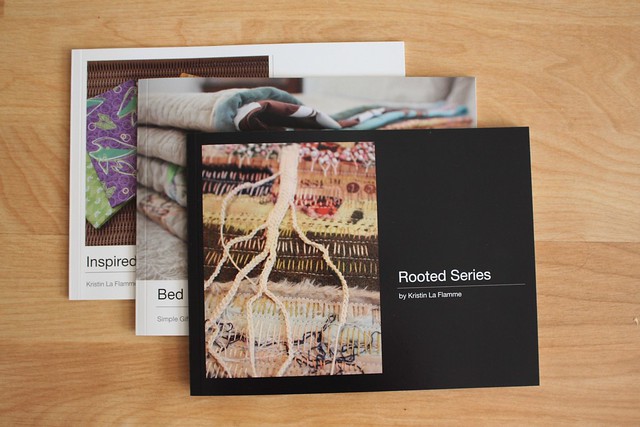
A picture is worth a thousand words, right? Smart phones and tablets have made it much easier for us fiber artists and art quilters to show people what it is that we create, rather than relying on imaginations that too quickly jump to underwater basket weaving and grandma's feed-sack quilts. I have photos of my work on my phone and am all too happy to pull up a picture when anyone shows any amount of curiosity. But my phone is small. So, I've taken to bringing along portfolio books whenever I think I might be in a situation where someone might want to see my work.
One of the best things about these books is that I can make one for each series of my work, or the different facets of my work. I don't have to worry about confusing my fabric collages with my bed quilts. I can choose to show one portfolio or the other, depending on the audience. My dad complained yesterday that he has to scroll through my blog to show his friends my work when they come to visit, so today I made a brag book that has all my recent work.

There are many ways to create these books. I have a Mac computer and it's set so that all my photos download directly into iPhoto. So, I've found it very easy to choose one of iPhoto's project templates, plug in the photos, write descriptions, upload it all to Apple, and expect a shiny book to arrive at my door in about a week. Other online printers and photo services also have similar templates, or you can design your own solution from scratch. The books that I order from Apple are best in small quantities, but I really like the elegant template, quality printing and absolute ease of creation.
Last week I was in Oregon and attended a reception at a gallery where one of my Army Wife aprons was part of a group show. I shared my Army Wife portfolio with the curator, and she asked if the gallery could keep the portfolio for the duration of the show. Of course! It will be a great ambassador for my series. I also showed two other portfolios at lunch during a quilt show in Portland as everyone sitting at our table was introducing themselves and describing what each of us does. Handy portfolios are now as much a part of my art business as my business cards are.

.jpg)
